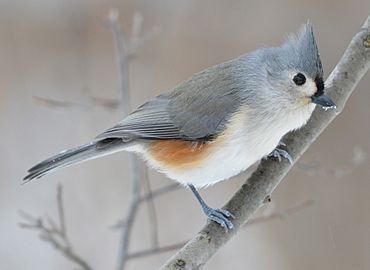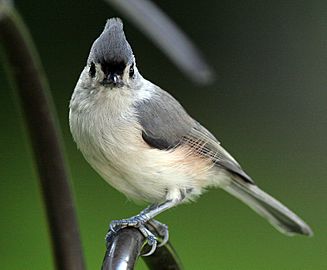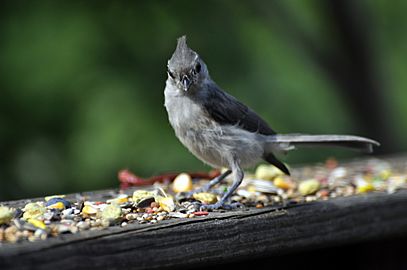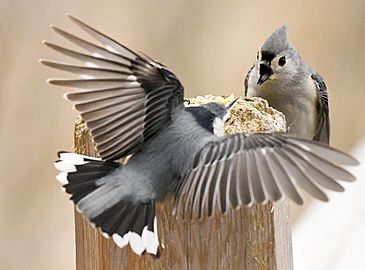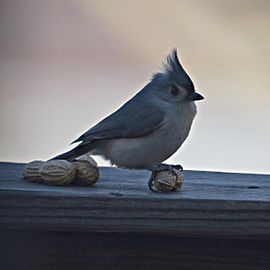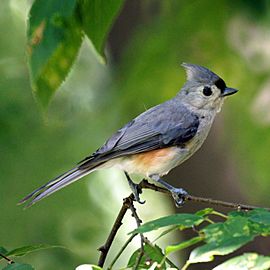Tufted titmouse facts for kids
The tufted titmouse (Baeolophus bicolor) is a small, lively songbird found in North America. It belongs to the tit and chickadee family (Paridae). You can often spot it by its cool, pointy grey crest on its head! Another bird, the black-crested titmouse, which lives in Texas, used to be considered the same species, but now scientists say they are different.
Quick facts for kids Tufted titmouse |
|
|---|---|
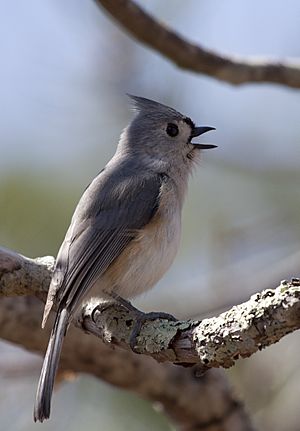 |
|
| Adult singing | |
| Conservation status | |
| Scientific classification | |
| Genus: |
Baeolophus
|
| Species: |
bicolor
|
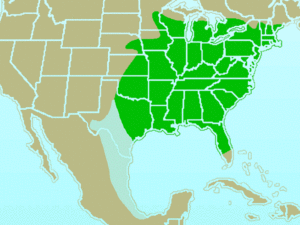 |
|
| Range of tufted titmouse in green | |
| Synonyms | |
|
Parus bicolor Linnaeus, 1766 |
|
Contents
What's in a Name?
The scientific name Baeolophus comes from ancient Greek words. Baiós means "small," and lóphos means "crest." So, Baeolophus means "small crested" – which makes sense for this bird!
The second part of its name, bicolor, means "two-colored." This describes its body, which has different shades of grey and white.
What Does It Look Like?
Tufted titmice are small birds, usually about 6 inches (15 cm) long. They weigh about as much as a few quarters, around 0.6 to 0.9 ounces (18-26 grams). Their wings can spread out about 8 to 10 inches (20-26 cm) wide.
These birds have a white front and a grey back. Their sides have a pretty rust-colored (reddish-brown) outline. They also have a black patch on their forehead and, of course, that famous grey crest on their head.
The song of the tufted titmouse sounds like a clear whistle, often described as "peter-peter-peter." But these clever birds can sing their song in about 20 different ways!
Where Does It Live?
Tufted titmice like to live in deciduous forests, which are woods where trees lose their leaves in the fall. They also live in mixed woods, gardens, parks, and bushy areas.
These birds do not migrate, meaning they stay in the same place all year. They were originally found in states like Ohio and Mississippi. However, because people put out bird feeders, these birds have spread out. Now, you can find them across much of the eastern United States and even into Ontario, Canada. Their population has grown a lot in the northeastern U.S. and some parts of the Midwest.
What Does It Eat?
Tufted titmice find their food both on the ground and in tree branches. They eat a variety of things, including berries, nuts, small fruits, snails, and seeds. During the summer, caterpillars are a very important part of their diet.
These smart birds often hide food to eat later. They can be quite curious about humans! Sometimes, they will sit on a window ledge and seem to peek inside a house. They might even cling to walls, looking for wasp or hornet nests to find food. Tufted titmice are common visitors at bird feeders. They usually watch the feeder from a safe spot, fly in quickly to grab a seed, and then fly back to cover to eat it.
Family Life
Tufted titmice build their nests inside holes in trees. They might use a natural hole, a nest box made by humans, or even an old woodpecker nest. They like to line their nests with soft materials. Sometimes, they even pluck hair from live animals, like a dog! If they find shed snake skin, they might add pieces of it to their nest too.
Their eggs are usually less than 1 inch (2.5 cm) long. They are white or cream-colored and have brownish or purplish spots.
A tufted titmouse usually lives for about 2 years, but some can live for more than 10 years. On average, a female bird will lay 5 to 7 eggs at a time. Unlike many other birds, young tufted titmice often stay with their parents through the winter. Sometimes, a bird born the year before will even help its parents raise the next group of young birds!
Gallery
-
Tufted Titmouse peeping at a White-breasted nuthatch.
See also
 In Spanish: Herrerillo bicolor para niños
In Spanish: Herrerillo bicolor para niños



